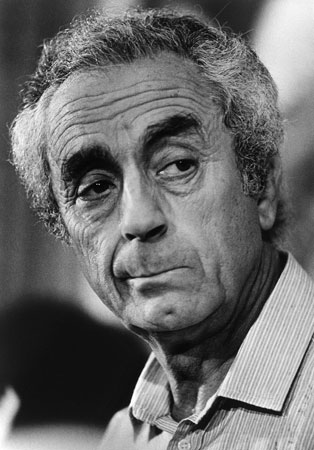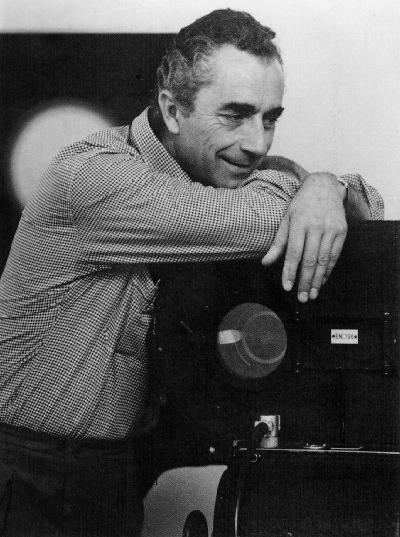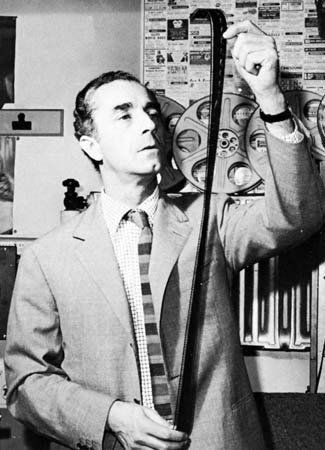<Back to Index>
- Film Director and Screenwriter Michelangelo Antonioni, 1912
PAGE SPONSOR
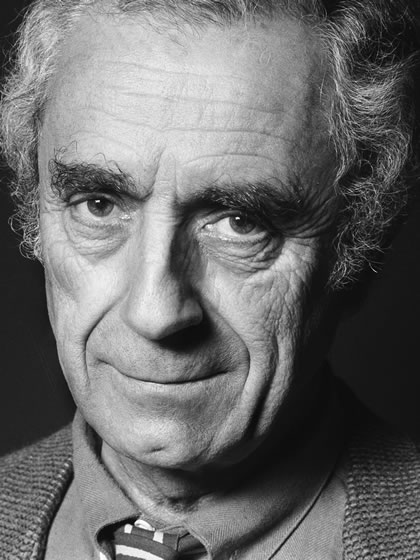
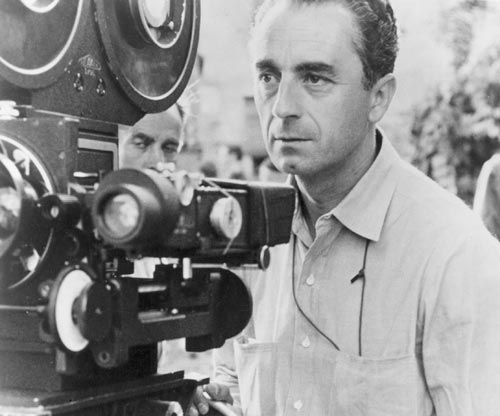
Michelangelo Antonioni, Cavaliere di Gran Croce OMRI (29 September 1912 – 30 July 2007) was an Italian modernist film director, screenwriter, editor and short story writer. Best known for his "trilogy on modernity and its discontents" — L'Avventura (1960), La Notte (1961) and Eclipse (1962) — Antonioni "redefined the concept of narrative cinema" and challenged traditional approaches to storytelling, realism, drama and the world at large. He produced "enigmatic and intricate mood pieces" and rejected action in favor of contemplation, focusing on image and design over character and story. His films defined a "cinema of possibilities".
Antonioni received numerous awards and nominations throughout his career, including the Cannes Film Festival Jury Prize (1960, 1962), Palme d'Or (1966), and 35th Anniversary Prize (1982); the Venice Film Festival Silver Lion (1955), Golden Lion (1964), FIPRESCI Prize (1964, 1995), and Pietro Bianchi Award (1998); the Italian National Syndicate of Film Journalists Silver Ribbon eight times; and an honorary Academy Award in 1995.
Antonioni was born into a prosperous family of landowners in Ferrara, Emilia Romagna, in northern Italy. He was the son of Elisabetta (née Roncagli) and Ismaele Antonioni. The director explained to Italian film critic Aldo Tassone:
My childhood was a happy one. My mother... was a warm and intelligent woman who had been a laborer in her youth. My father also was a good man. Born into a working class family, he succeeded in obtaining a comfortable position through evening courses and hard work. My parents gave me free rein to do what I wanted: with my brother, we spent most of our time playing outside with friends. Curiously enough, our friends were invariably proletarian, and poor. The poor still existed at that time, you recognized them by their clothes. But even in the way they wore their clothes, there was a fantasy, a frankness that made me prefer them to boys of bourgeois families. I always had sympathy for young women of working class families, even later when I attended university: they were more authentic and spontaneous.
While still a child, Antonioni was fond of drawing and music. A precocious violinist, he gave his first concert at the age of nine. Although he abandoned the violin with the discovery of cinema in his teens, drawing would remain a lifelong passion. "I have never drawn, even as a child, either puppets or silhouettes but rather facades of houses and gates. One of my favorite games consisted of organizing towns. Ignorant in architecture, I constructed buildings and streets crammed with little figures. I invented stories for them. These childhood happenings - I was eleven years old - were like little films."
Upon graduation from the University of Bologna with a degree in economics, he started writing for the local Ferrara newspaper Il Corriere Padano in 1935 as a film journalist.
In 1940, Antonioni moved to Rome, where he worked for Cinema, the official Fascist film magazine edited by Vittorio Mussolini. However, Antonioni was fired a few months afterward. Later that year he enrolled at the Centro Sperimentale di Cinematografia to study film technique, but left it after three months. He was drafted into the army afterwards.
Antonioni died aged 94 on July 30, 2007 in Rome, the same day that another renowned film director, Ingmar Bergman, also died. Antonioni lay in state at City Hall in Rome where a large screen showed black - and - white footage of him among his film sets and behind - the - scenes. He was buried in his home town of Ferrara on August 2, 2007.
He was an atheist.
In 1942, Antonioni co-wrote Un pilota ritorna with Roberto Rossellini and worked as assistant director on Enrico Fulchignoni's I due Foscari. In 1943, he traveled to France to assist Marcel Carné on Les visiteurs du soir and then began a series of short films with Gente del Po (1943), a story of poor fishermen of the Po valley. After the Liberation, the film stock was stored in the East - Italian Fascist "Republic of Salň" and could not be recovered and edited until 1947 (the complete footage was never retrieved). These films were neorealist in style, being semi - documentary studies of the lives of ordinary people.
However, Antonioni's first full length feature film Cronaca di un amore (1950) broke away from neorealism by depicting the middle classes. He continued to do so in a series of other films : I vinti ("The Vanquished", 1952), a trio of stories, each set in a different country (France, Italy and England), about juvenile delinquency; La signora senza camelie (The Lady Without Camellias, 1953) about a young film star and her fall from grace; and Le amiche (The Girlfriends, 1955) about middle class women in Turin. Il grido (The Outcry, 1957) was a return to working class stories, depicting a factory worker and his daughter. Each of these stories is about social alienation.
In Le Amiche (1955), Antonioni experimented with a radical new style: instead of a conventional narrative, he presented a series of apparently disconnected events, and he used long takes as part of his film making style. Antonioni returned to their use in L'avventura (1960), which became his first international success. At the Cannes Film Festival it received a mixture of cheers and boos, but the film was popular in art house cinemas around the world. La notte (1961), starring Jeanne Moreau and Marcello Mastroianni, and L'eclisse (1962), starring Alain Delon, followed L'avventura. These three films are commonly referred to as a trilogy because they are stylistically similar and all concerned with the alienation of man in the modern world. La notte won the Golden Bear award at the 11th Berlin International Film Festival, His first color film, Il deserto rosso (The Red Desert, 1964), deals with similar themes, and is sometimes considered the fourth film of the "trilogy". All of these films star Monica Vitti, his lover during that period.
Antonioni then signed a deal with producer Carlo Ponti that would allow artistic freedom on three films in English to be released by MGM. The first, Blowup (1966), set in Swinging London, was a major international success. The script was loosely based on the short story The Devil's Drool (otherwise known as Blow Up) by Argentinian writer Julio Cortázar. Although it dealt with the challenging theme of the impossibility of objective standards and the ever - doubtable truth of memory, it was a successful and popular hit with audiences, no doubt helped by its sex scenes, which were explicit for the time. It starred David Hemmings and Vanessa Redgrave. The second film was Zabriskie Point (1970), his first set in America and with a counterculture theme. The soundtrack carried popular artists such as Pink Floyd (who wrote new music specifically for the film), the Grateful Dead and the Rolling Stones. However, its release was a critical and commercial disaster. The third, The Passenger (1975), starring Jack Nicholson and Maria Schneider, received critical praise, but also did poorly at the box office. It was out of circulation for many years, but was re-released for a limited theatrical run in October 2005 and has subsequently been released on DVD.
In 1972, in between Zabriskie Point and The Passenger, Antonioni was invited by the Mao government of the People's Republic of China to visit the country. He made the documentary Chung Kuo, Cina, but it was severely denounced by the Chinese authorities as "anti - Chinese" and "anti - communist". The documentary had its first showing in China on November 25, 2004 in Beijing with a film festival hosted by the Beijing Film Academy to honor the works of Michelangelo Antonioni.
In 1980, Antonioni made Il mistero di Oberwald (The Mystery of Oberwald), an experiment in the electronic treatment of color, recorded in video and then translated to film, featuring Monica Vitti once more. It is based on Jean Cocteau's play L'Aigle ŕ deux tętes (The Eagle With Two Heads). Identificazione di una donna (Identification of a Woman, 1982), filmed in Italy, deals one more time with the recursive subjects of his Italian trilogy. In 1985, Antonioni suffered a stroke, which left him partly paralyzed and unable to speak. However, he continued to make films, including Beyond the Clouds (1995), for which Wim Wenders filmed some scenes. As Wenders has explained, Antonioni rejected almost all the material filmed by Wenders during the editing, except for a few short interludes. They shared the FIPRESCI Prize at the Venice Film Festival with Cyclo.
In 1994 he was given the Honorary Academy Award "in recognition of his place as one of the cinema's master visual stylists." It was presented to him by Jack Nicholson. Months later, the statuette was stolen by burglars and had to be replaced. Previously, he had been nominated for Academy Awards for Best Director and Best Screenplay for Blowup. Antonioni's final film, made when he was in his 90s, was a segment of the anthology film Eros (2004), entitled "Il filo pericoloso delle cose" ("The Dangerous Thread of Things"). The short film's episodes are framed by dreamy paintings and the song "Michelangelo Antonioni", composed and sung by Caetano Veloso. However, it was not well received internationally; in America, for example, Roger Ebert claimed that it was neither erotic nor about eroticism. The U.S. DVD release of the film includes another 2004 short film by Antonioni, Lo sguardo di Michelangelo (The Gaze of Michelangelo).
Film historian Virginia Wright Wexman describes Antonioni's perspective on the world as that of a "postreligious Marxist and existentialist intellectual." In a speech at Cannes about L'Avventura, Antonioni said that in the modern age of reason and science, mankind still lives by "a rigid and stereotyped morality which all of us recognize as such and yet sustain out of cowardice and sheer laziness". He said his films explore the paradox that "we have examined those moral attitudes very carefully, we have dissected them and analyzed them to the point of exhaustion. We have been capable of all this, but we have not been capable of finding new ones." Nine years later he expressed a similar attitude in an interview, saying that he loathed the word 'morality': "When man becomes reconciled to nature, when space becomes his true background, these words and concepts will have lost their meaning, and we will no longer have to use them."
One of the recurring themes in Antonioni's films is characters who suffer from ennui and whose lives are empty and purposeless aside from the gratification of pleasure or the pursuit of material wealth. Film historian David Bordwell writes that in his films, "Vacations, parties and artistic pursuits are vain efforts to conceal the characters' lack of purpose and emotion. Sexuality is reduced to casual seduction, enterprise to the pursuit of wealth at any cost." Antonioni's films tend to have spare plots and dialogue, and much of the screen time is spent lingering on certain settings, such as the seven minute continuous take in The Passenger, or the scene in L'Eclisse in which Monica Vitti stares curiously at electrical posts accompanied by ambient sounds of wires clanking. Virginia Wright Wexman summarizes his style in the following terms: "The camera is placed at a medium distance more often than close in, frequently moving slowly; the shots are permitted to extend uninterrupted by cutting. Thus each image is more complex, containing more information than it would in a style in which a smaller area is framed ... In Antonioni's work we must regard his images at length; he forces our full attention by continuing the shot long after others would cut away." Antonioni is also noted for exploiting color as a significant expressive element of his cinematic style, especially in Il deserto rosso, his first color film.
Bordwell explains that Antonioni's films were extremely influential on subsequent art films: "More than any other director, he encouraged filmmakers to explore elliptical and open - ended narrative". Film director Akira Kurosawa considered Antonioni one of the most interesting filmmakers. Stanley Kubrick listed La Notte as one of his ten favorite films in a 1963 Poll. Andrei Tarkovsky also listed Antonioni as one of his favorite filmmakers. Miklós Jancsó considers Antonioni as his master.
Antonioni's spare style and purposeless characters, however, have not received universal acclaim. Ingmar Bergman stated in 2002 that he considered some of Antonioni's films, including Blowup and La notte, masterpieces for their detached and dreamlike quality, but found the other films boring and noted that he had never understood why Antonioni was held in such esteem. Ironically, both Bergman and Antonioni died on the same date. Orson Welles regretted the Italian director's use of the long take: "I don't like to dwell on things. It's one of the reasons I'm so bored with Antonioni - the belief that, because a shot is good, it's going to get better if you keep looking at it. He gives you a full shot of somebody walking down a road. And you think, 'Well, he's not going to carry that woman all the way up that road.' But he does. And then she leaves and you go on looking at the road after she's gone."
American actor Peter Weller, whom Antonioni directed in Beyond the Clouds, explained in a 1996 interview: "There is no director living except maybe Kurosawa, Bergman or Antonioni that I would fall down and do anything for. I met Antonioni three years ago in Taormina at a film festival. I introduced myself and told him that I adored his movies, his contributions to film, because he was the first guy who really started making films about the reality of the vacuity between people, the difficulty in traversing this space between lovers in modern day... and he never gives you an answer, Antonioni – that's the beautiful thing."
